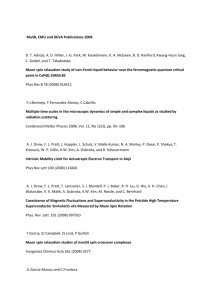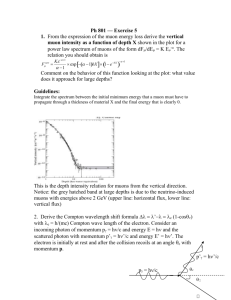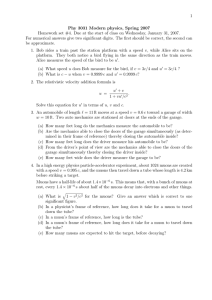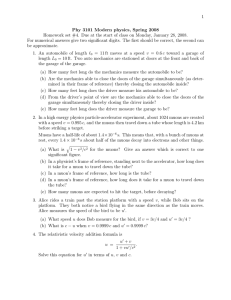Investigation of materials using μSR Adrian Hillier ISIS Muon Group
advertisement
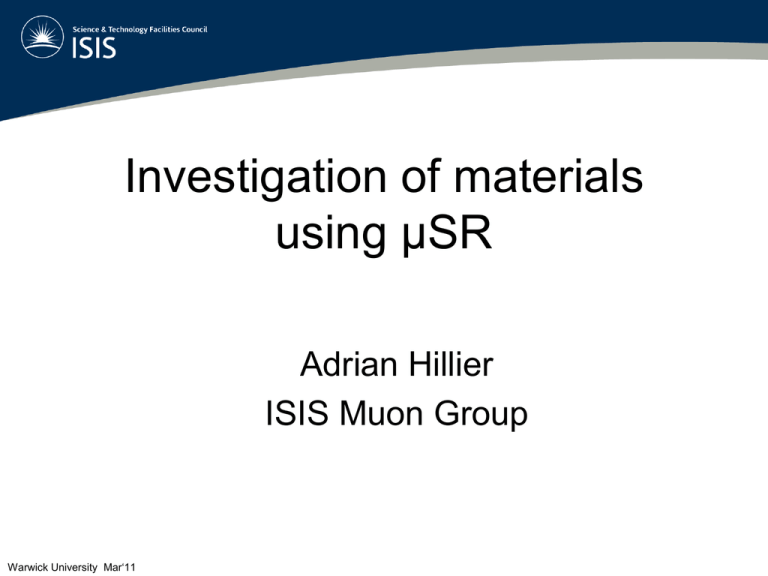
Investigation of materials using μSR Adrian Hillier ISIS Muon Group Warwick University Mar‘11 Lecture Plan Introduction Setting the muon in its historical context Properties Production of muons Sources • Techniques • Applications of μSR to materials MuSR instrument at ISIS Relaxation Bz or B=0 m F Rz(t) F(t)B(t) aoGz (t) F(t)B(t) B The many faces of mSR Longitudinal zero field - mSR muons Precessing polarisation Precessing and relaxing polarisation Relaxing signal 0.4 0.4 Asymmetry Asymmetry Asymmetry 0.3 0.3 0.2 0.2 0.1 0.1 0.0 0.0 -0.1 -0.1 Detector A Detector B 00 22 44 66 Time (ms) Time (ms) 88 10 10 Relaxation functions Muon Spin Precession Pz (t) cos 2 sin2 cos( m Bt) |B| is the modulus of the local dipolar field Muon Spin Precession Pz (t) cos 2 sin2 cos( m Bt) 1.5 Pz(t) 1.0 θ=0 0.5 θ=π/2 0.0 -0.5 -1.0 depends on θ -1.5 Time Muon Spin Precession Pz (t) cos 2 sin2 cos( m Bt) Angular Averages: <cos2θ>=1/3 <sin2θ>=2/3 Pz (t) 1/3 2/3cos( m Bt) 1.5 1.0 Pz(t) 0.5 0.0 -0.5 -1.0 -1.5 Time Muon Spin Precession Muon Spin Precession Now assume B is distributed according to a Gaussian distribution P(B) P(B) α B2exp(-γ2B2/2Δ2) B Kubo-Toyabe functions Gz (t) cos sin cos( m Bt)P(B )P(B )P(B )d B 2 2 3 x y z Recovery Apply a longitudinal field and see the recovery Oscillation is at the applied field Dilute Spin system Dilute spin -> Lorentzian distribution P(Bi ) m a a2 m2 B 2 Dynamics “Strong Collision” approximation Assume: 1/ local field on muon is suddenly changed and after which is not correlated with the previous state 2/ Collision take place at a rate ν B(t)B(0) exp(t) 2 B (0) Summing Up Gz(t,ν)= muons that don’t collide + muons that collide once + muons that collide twice etc Rotation Bx >0 m F Rx(t) F(t) B(t) aoGx(t)cos(Lt) F(t) B(t) B The many faces of mSR Transverse field mSR muons non-relaxing polarisation magnetic field relaxing polarisation 25 20 20 15 asymmetry Y Axis Title 10 10 5 0 0 -5 -10 -10 -15 -20 -20 -25 00 1 22 3 44 5 X Axis Title time (ms) 66 7 88 Applications of μSR to materials Science with muons Muons as probe particles can inform on superconductivity, magnetism, molecular dynamics, charge transport . . . Muons at ISIS MUONS: • Versatile probes of magnetic, superconducting, molecular systems • Analogues of protons/hydrogen in semiconductors • Complementary to other techniques ISIS / PSI / J-PARC all have neutron and muon facilities • Around 60 groups from 20 countries using ISIS muons Radical studies 11% Molecular dynamics 2% Light particle diffusion 2% Inorganic magnetism 31% Spintronics 4% Other H studies 4% H in other semiconds. 7% H in II-VIs and oxides 9% Other 1% Organic magnetism/ supercond. 15% Polymer charge transport 3% Ion/proton transport 2% Inorganic supercond. 9% Magnetism CeRu2Al10 Khalyavin, Hillier et al Phy. Rev. B 82 100405R (2010) CeRu2Al10 Khalyavin, Hillier et al Phy. Rev. B 82 100405R (2010) CeRu2Al10 Khalyavin, Hillier et al Phy. Rev. B 82 100405R (2010) Sr3ZnRhO6 Hillier et al Phys. Rev. B 83 24414 (2011) Sr3ZnRhO6 Hillier et al Phys. Rev. B 83 24414 (2011) NaxCoO2 Mendel et al PRL 94 136403 (2004) Spin dynamics in frustrated systems First order transition in the spin dynamics of geometrically frustrated Yb2Ti2O7 J Hodges et al, PRL 88 (2002) 077204 • Yb2Ti2O7 - pyrochlore exhibiting geometrical frustration • Neutron diffraction, Mossbauer spectroscopy and mSR used to characterise magnetic behaviour • First order transition at 0.24K is not to long (or short) range order, but is a change in the Yb3+ fluctuation rate. Superconductivity Superconducting transition temperature (K) Superconductivity in alloys and oxides 160 HgBa2Ca2Cu3O9 (under pressure) 140 HgBa2Ca2Cu3O9 120 TlBaCaCuO BiCaSrCuO 100 YBa2Cu3O7 Liquid Nitrogen temperature (77K) 80 60 (LaBa)CuO 40 20 Hg Pb Nb 1910 NbC NbN 1930 Nb3Sn Nb3Ge V3Si 1950 1970 1990 The two characteristic length scales - the coherence length l - the penetration depth The length scale over which the superconducting wave function varies The length scale over which the flux density varies The mixed state in Type II superconductors Hc1< H <Hc2 The bulk is diamagnetic but it is threaded with normal cores B The flux within each core is generated by a vortex of supercurrent Hc1 0 -M Hc2 H The flux lattice 2mm 10mm Small angle neutron scattering R multidetector 64x64cm2 L B scattering angle 2 sample incident neutron beam Probing the flux lattice with muons 100nm Calculating the field distribution The second moment of the field distribution is given by B 2 1 2 1/ 2 0.00371o2 l4 In this case the transverse field relaxation, Gx(t) is also Gaussian: 2t2 Gx(t)e 75780 2 l with in ms-1 and l in nm. The Gaussian approximation thus provides a simple relationship between and l, -and is often a reasonable approximation FeTe0.5Se0.5 Biswas et al Phys. Rev. B, 81 92510 (2010) FeTe0.5Se0.5 Lu2Fe3Si5 Biswas et al Phys. Rev. B, 83 54517 (2011) Lu2Fe3Si5 T=6.5K T=0.3K Biswas et al Phys. Rev. B, 83 54517 (2011) Lu2Fe3Si5 Biswas et al Phys. Rev. B, 83 54517 (2011) What about type I? LaRhSi3 Anard, Hillier et al Phys. Rev. B 83 64522 (2011) LaRhSi3 Semiconductors Shallow donor states in II-VI semiconductors • First experimental evidence of muonium (and hence hydrogen) forming shallow donor states in semiconductors • Of very real interest to semiconductor community • Pulsed muon source essential to allow measurements to long times - ISIS is unique in Europe. Shallow donor muonium states in II-VI semiconductor compounds J Gil et al, PRB 64 (2001) 075205 Particle Diffusion Li ion mobility in battery electrode material • Li-based cathode materials can be used to produce solid state batteries which are cheap and light. • Optimisation requires knowledge of Li ion mobility for different compositions. • Implanted muons can be used to follow the Li ion diffusion behaviour, revealing composition-dependent onset temperatures. Li mobility in the battery cathode material Lix[Mn1.96Li0.04]O4 studied by muon spin relaxation C Kaiser et al, Phys Rev B 62 (2000) R9236. Sugiyama et al, Phys. Rev. Lett. 103 147601 (2009) Ariza et al, J. Phys. Chem 107 6003 (2003) Proton diffusion in ReO3 • HxMO3 materials have applications as catalysts, displays, etc. Proton sites and motion are central to their properties. • Observe muon behaviour to inform on protons • Muon linewidth can be calculated given relative positions of m+ and Re. Proton diffusion in ReO3 B 0.10 C 0.08 -1 ( ms ) A - static interstitial with distortion B - rapidly rotating O-m, no long-range motion C - Diffusion between O-Mu sites D - Trapping at a defect E - diffusion between D E trapping sites A 0.12 0.06 0.04 0.02 0.00 0 100 200 300 400 500 600 Temperature (K) A B C D Muon study of proton sites in rhenium oxide JS Lord et al. Summary • Muons provide a unique probe of atomic structure/dynamics, often providing complementary information to that given by neutrons. • They can be used as sensitive probe particles to investigate molecular dynamics, magnetism, superconductivity, charge transport . . . • They can be used as proton analogues to provide models of hydrogen atom behaviour . . . for example in semiconductors, proton conductors, hydrogen storage materials, etc.
